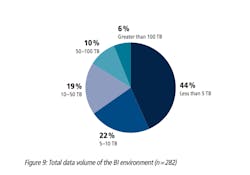Recent articles on Big Data in the manufacturing space proclaim the virtues of a connected factory and/or enterprise, but also illustrate the reality of inadequate data quality and visibility in enterprises. A recent AutomationWorld.com blog post by Aaron Hand on this very topic seems to indicate that industrial manufacturers in the U.S. are actually spending a very small percentage of their IT budgets on Big Data, but are still intrigued by the possibilities.
This Big Data sentiment in the U.S parallels what’s going on in Europe, at least according to a recent report from Groupe Steria SCA entitled, “Business Intelligence (BI): Are European Companies Ready for Big Data?”
From a survey sample size of 668 participants with considerable representation from large companies in the manufacturing space, the survey finds that “companies are not dealing with the first three fundamentals of big data―volume, variety and velocity.”
The report cites that scaling options related to rapidly growing data solutions only represent a serious problem for 8 percent of companies. Clearly, the challenge of implementing big data systems is not being taken up by many.
The survey included respondents from Germany, France, U.K., Scandinavia, Poland, Austria and Switzerland. IT and manufacturing comprised the largest business categories represented, at 22 percent and18 percent, respectively. Other industries include life sciences, utilities, automotive and the public sector.
The report reveals that the biggest obstacles to creating business intelligence are:
- Inadequate data quality (38 percent);
- Lack of a generally accepted BI strategy (33 percent);
- Lack of adequate processes and responsibilities for BI (21 percent).
Data integrity or quality is not a new challenge, and it’s one made worse by the extent of legacy systems. In a recent webinar on Manufacturing Operations Management (MOM), Charlie Giffords, chairman of the ISA-95 Best Practices committee, says, “After 10 years, a typical plant will end up with 10 to 20 departmental systems that are using multiple definitions to process a single production order. Poor data integrity and process analysis leads to poor decision making.”
The BI report illustrates that specific industries value Big Data slightly more than others. “Life science is a bit ahead of automotive, but still far from valid, defined use cases and implementations,” says Asteria's principal EIM consultant, Volker Ossendoth. Specifically, “relevance” for life science sectorrates at 2.7 out of 5, and the current target achievement is valued at 2.5 of out of 5.
By comparison, the relevance of Big Data in the automotive sector is moderate, rated at 2.6 out of 5, while the current target achievement there is low, rated 2.2 out of 5.
About the Author
Grant Gerke
Digital Managing Editor

Leaders relevant to this article:
